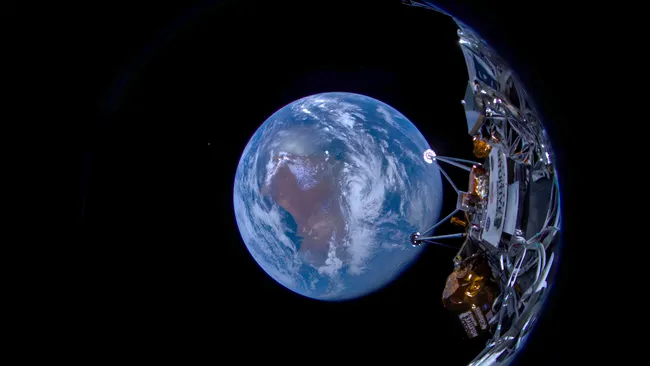Odysseus moon lander, Earth technosignatures, alien civilizations, radio astronomy, lunar exploration, ROLSES experiment, Jack Burns, Intuitive Machines, exoplanet study, extraterrestrial intelligence
Discover how the Odysseus moon lander has unveiled Earth’s technosignatures, revealing what alien civilizations might see. Learn about the groundbreaking ROLSES experiment, the challenges faced during the mission, and the future of lunar radio astronomy in the search for extraterrestrial intelligence.

Private Odysseus Moon Lander Reveals Earth ‘Technosignatures’ Aliens Might See
In a groundbreaking achievement, the Intuitive Machines’ Odysseus moon lander has unveiled which Earth ‘technosignatures’ might be detectable by alien civilizations. This revelation comes from a pioneering experiment that captured radio waves emitted by human technology from the moon’s surface for the first time. Astrophysicist Jack Burns from the University of Colorado Boulder described this event as the “dawn of radio astronomy from the moon,” marking a significant milestone in space exploration and the search for extraterrestrial intelligence.
The Journey of the Odysseus Moon Lander
The Odysseus moon lander, a commercial spacecraft, successfully landed on the moon on February 22, 2024, following its launch atop a SpaceX Falcon 9 rocket. The mission, spearheaded by Intuitive Machines, aimed to enhance our understanding of radio waves emanating from Earth and explore their potential detectability by alien civilizations. A small radio telescope aboard the Odysseus, part of the Radio Observatory for Lunar Surface and Environment Science (ROLSES) experiment, recorded these radio waves from its landing site near the Malapert A crater, approximately 185 miles from the moon’s south pole.
Capturing Earth’s Radio Waves
For 1.5 hours, the ROLSES instrument recorded radio signals beamed from Earth. The significance of this achievement lies in the potential it offers for studying Earth as an exoplanet. By analyzing these radio waves, scientists hope to identify similar signals from distant planets, which could indicate the presence of intelligent life.
During the 244th meeting of the American Astronomical Society in Wisconsin, Burns showcased an image featuring tiny white dots scattered against a black background, forming horizontal lines. These white specks represent radio signals from Earth’s transmitters, offering an unparalleled view of Earth in radio wavelengths. Burns described this as “a really good ‘frequency selfie’ of the Earth,” highlighting the importance of this data in the search for extraterrestrial intelligence.
Challenges and Unexpected Discoveries
The historic landing of the 14-foot Odysseus spacecraft was not without challenges. The spacecraft descended faster than anticipated and tipped over upon landing, likely damaging one or two of its landing legs. This unexpected orientation hindered the spacecraft’s antennas from pointing back at Earth, significantly reducing the data transmission rate.
As a result, the ROLSES instrument recorded data for only two hours instead of the planned eight days. Despite this limitation, the researchers were able to capture valuable data. Burns noted that the reduced recording time affected the signal-to-noise ratio, but the collected data still holds significant value.
One serendipitous moment occurred when one of Odysseus’ antennas overheated and popped out of its secure place on the lander, allowing the researchers to gather an additional 20 minutes of data. Burns emphasized the importance of seizing this opportunity to collect more information.
End of a Historic Mission
After a week of operations, Odysseus went silent on February 29, when the sun set at its landing site. This was expected, as the spacecraft was not designed to withstand the cold lunar night. Despite hopes that it might revive when sunlight returned on March 20, Intuitive Machines did not receive a wake-up signal. On March 23, the company officially declared the mission over, noting that “Odie has permanently faded after cementing its legacy into history as the first commercial lunar lander to land on the moon.”
Future Prospects in Lunar Radio Astronomy
Looking ahead, astronomers, including Burns, are eagerly anticipating the launch of another small radio telescope, the Lunar Surface Electromagnetics Experiment-Night (LuSEE-Night). Scheduled to launch in 2026, this instrument aims to detect radio waves from 13.4 billion years ago, a period known as the cosmic Dark Ages. During this era, the universe and its first stars and galaxies were shrouded in a primordial fog of hydrogen. The James Webb Space Telescope has only recently begun probing this mysterious epoch.
LuSEE-Night will be deployed on the far side of the moon, providing an ideal location for detecting faint radio signals without interference from Earth. By studying these ancient radio waves, astronomers hope to gain new insights into the early universe and the formation of its first structures.
Implications for the Search for Extraterrestrial Intelligence
The successful detection of Earth’s radio waves from the moon opens up new possibilities in the search for extraterrestrial intelligence. By studying our own planet as an exoplanet, scientists can refine their methods for identifying technosignatures from distant worlds. This approach enhances the likelihood of detecting signs of intelligent life beyond our solar system.
The ROLSES experiment and future missions like LuSEE-Night demonstrate the potential of lunar radio astronomy in advancing our understanding of the universe. By leveraging the moon’s unique environment, free from the radio noise of Earth, astronomers can explore new frontiers in the search for extraterrestrial intelligence.
Conclusion
The achievements of the Odysseus moon lander represent a significant step forward in space exploration and the quest to uncover signs of intelligent life beyond Earth. Despite the challenges faced during its mission, the data collected by the ROLSES experiment provides invaluable insights into the detectability of Earth’s technosignatures. As astronomers continue to develop new technologies and conduct innovative experiments, the dream of discovering extraterrestrial intelligence becomes increasingly tangible. The dawn of radio astronomy from the moon heralds a new era in our exploration of the cosmos, one that promises exciting discoveries and profound implications for our understanding of the universe and our place within it.
Read More
- NASA PREFIRE Mission: Tiny Satellites Measuring Earth’s Polar Heat Loss
- NASA Launches Tiny CubeSat to Revolutionize Earth Observation
- NASA Pioneering Airborne Missions: Advancing Earth and Climate Science
- NASA Unveils a Mind Blowing Super Earth 137 Light-Years Away









